Work on the scientific-practical conference. How to write a research paper and prepare for a conference
SCHOOL SCIENTIFIC CONFERENCE FOR STUDENTS OF 1-4 GRADES AND STUDENTS OF SP-KINDERGARTENS
SECTION "Literature"
My dictionary
student 2 - B class
GBOU secondary school with. Alekseevka " Education Centre»
Scientific adviser: Golovacheva Galina Viktorovna,
teacher primary school
Consultants: Zaitseva Lidia Ivanovna,
teacher of Russian language and literature
Alekseevka, 2014
TABLE OF CONTENTS
1. INTRODUCTION ……………………………………………………. page
2. MAIN PART ………………………………………… p.
- Theoretical part
- Practical part
3. CONCLUSION ………………………………………………. page
INTRODUCTION
Need for expansion vocabulary students for a variety of reasons. The surrounding life, studying at school, reading books, newspapers, magazines, listening to radio and television programs enrich the knowledge of children, along with which often come unfamiliar words. The assimilation of knowledge at the same time involves the memorization of new words. Possession of a large vocabulary provides the student with a better understanding of what is being read, free, easy communication in different groups of people. The desire of children to replenish their vocabulary should be supported by the school.
The topic of my work: "Expanding the vocabulary in reading lessons"
Problem: Expanding students' vocabulary
Title: "What is a lexicon and ways to expand it"
Importance and relevance My problem is that without finding out the lexical meanings of words, it is impossible to work further on the text. Acquaintance with new words broadens the horizon, develops speech and communication skills of a person.
Tasks:
Finding unknown words in the text.
Determining the lexical meaning of words using the Ozhegov Explanatory Dictionary.
Acquaintance with dictionaries (Ozhegova, Dalia).
Compilation of personal explanatory dictionaries (with illustrated design of some words).
Acquaintance of children with Internet resources (children's illustrated dictionary, online dictionary).
Methods for studying the problem:
1. Statistical approach, when I counted the number of incomprehensible words (in 10 texts we met 27 unfamiliar words).
2. Analysis of the text, its meaning.
3. Classification.
4. Compilation of dictionaries.
The product of my project was a DIctionary.
MAIN PART
1. Theoretical part
At present, the state is in demand for intellectually developed, sociable, creative, educated individuals who are able to work in various professional fields. The Russian language and literary reading as subjects occupy a special place in primary education, as they are aimed at developing the functional literacy of children of primary school age. It is known that success in mastering the language of instruction is the most important condition for the overall success of the education of schoolchildren, that is, proficiency in oral and written speech acts as a special educational skill, as well as necessary for studying any subject. elementary school.
One of the main tasks of teaching children of primary school age is the development of a student as a person who fully owns oral and written speech. The main task is set before the teacher: to lay the foundations of cultural communication, to form communication skills, and most importantly - a friendly attitude towards people. Lexical work is considered as a means of developing a child's speech and a means of shaping his life position, the features of an individual vocabulary of a younger student in terms of vocabulary are studied. The criterion for the formation of children's speech is the ability to correctly understand the lexical meaning of a word, know its grammatical properties, be able to pronounce correctly and write correctly, and consciously use the word in one's speech.
Mastering the native language as a means and way of communication and cognition is one of the most important acquisitions of a child in school age. Enriching the child's vocabulary, working on the lexical meaning of the word will help to some extent in solving this problem.
Vocabulary refers to the words we need to know so that we can communicate, listen, speak, read, and write effectively. Vocabulary plays an important role in learning to read. Children use words in their speech, learn the meaning of the words they see in print. Vocabulary is also important in understanding what you read. Readers will not be able to understand and comprehend what they are reading if they do not know the meaning of most of the words.
Vocabulary is essential for children who read, but they begin to build their vocabulary before they learn to read and continue to accumulate it after they have mastered the basics of reading. In fact, for most people, vocabulary expansion continues throughout their lives.
For a modern school, an extremely important part is the problem of enriching the vocabulary of students. This is one of the main tasks of primary education. This problem has been and continues to be dealt with by a number of domestic and foreign scientists. modern school should prepare a person who thinks and feels, who not only has knowledge, but also knows how to use this knowledge in life, who knows how to communicate and has an internal culture.
Mastery of language and speech is a necessary condition for the formation of a socially active personality.
Everyone needs to learn how to express their thoughts well and correctly in oral and written form, to be able to speak and write convincingly, vividly.
It is known that one of the indicators of the level of a person's culture, thinking, intellect is his speech, which must comply with linguistic norms.
Many teachers worked on the problem of speech development and vocabulary enrichment. The theoretical basis of the work was the works of scientists on the theory of the personality-activity approach to learning (L.S. Vygotsky, P.Ya. Galperin, A.N. Leontiev, S.L. Rubinshtein and others), on the theory of teaching methods (I. Ya. Lerner, M.S. Skatkin, L.P. Fedorenko and others), research on the methodology of teaching the Russian language and literature (N.N. Algazina, M.T. Baranov, L.E. Zhurova, V.V. Babaitseva, A.V. Tekuchev, T.G. Ramzaeva, M.R. Lvov, etc.).
The question is very relevant, since COMMUNICATIVE COMPETENCES depend on it.
The lexicon is the same as the dictionary (in I meaning) (obsolete); vocabulary, vocabulary (book). ( Dictionary Russian language Ozhegov)
It's different for every person. For example, at Ellochka Ludoedova, he made up only a few words, and that was enough for her. But the lexicon of the great Russian poet Alexander Sergeevich Pushkin consisted of several thousand words, but he was constantly improving, expanding it.
What are the ways to expand the lexicon?
M.R. Lvov ranks the sources of vocabulary enrichment according to the degree of influence on the speech of children:
1. Speech environment in the family, among friends.
2. Speech environment: books, newspapers, radio, television.
3. Academic work at school (textbooks, teacher's speech).
4. Dictionaries, reference books.
The best source of dictionary enrichment is live communication, speech, oral and written, literature: the word in the text is always, as it were, highlighted semantically and artistically.
One of the ways to expand the vocabulary is to get acquainted with new words.
2. Practical part
Where does the work begin?
1. Analysis of the text we are reading. We find and write out incomprehensible words in dictionaries.
2. Finding out the meaning of words. First, we try to find out on our own, based on the context, if we can’t, we resort to explanatory dictionaries.
3. Use of explanatory dictionaries.
(We are familiar with the School phraseological dictionary, Dahl's dictionary, Ozhegov's dictionary).
4. Compilation of a personal explanatory dictionary.
My teacher told me how Jack London (Mark Eden) expanded his lexical vocabulary: he wrote out unfamiliar words on sheets of paper and pasted them around the room in prominent places. In every free minute he looked at the leaves and tried to understand the meaning. TThus, seeing them constantly, he memorized them, thus replenishing and expanding his vocabulary.
I compile my dictionary alphabetically. Some words are accompanied by illustrations.
During the work on the project, I got acquainted with 27 new words. For example, now I know what words likedilapidated dugout, seine, prayed, said, elder.
How do I use words? With them, I make sentences in the lessons of the Russian language, oral answers in the lessons of the world around and literary reading I incorporate them into my daily life.
CONCLUSION
Learning and expanding human vocabulary is an important task for every student of our school. Without it, we will not be able to communicate, develop our communication skills. Speech should be beautiful, rich. It is this that allows us to make it filling with new words, expanding our vocabulary. Over the past month, I have expanded my vocabulary by 27 words.
LIST OF USED SOURCES AND LITERATURE
Dictionaries
Bukhbinder V. A., Rozanov E. D. On the integrity and structure of the text. - “Vopr. Linguistics”, 1975, No. 6.
On-line resources
Design Font: Times New Roman Cyr Size: 14 pt Spacing: - single Font for footnotes, tables, captions under figures - 12 pt Margins: -Top - 2 cm -Bottom - 2 cm -Left - 3 cm -Right - 1.5 cm –Page numbering starting at 2 (the title page is counted but not numbered).
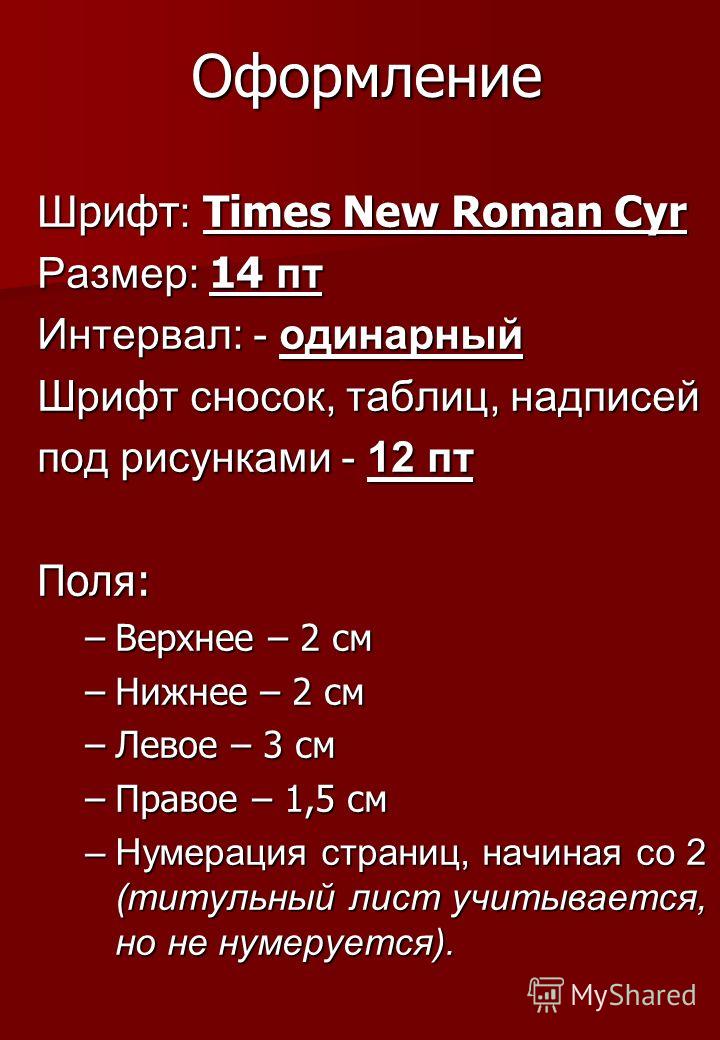
Research work "name" Municipal budgetary educational institution"Average comprehensive school 125 s in-depth study mathematics "XIV scientific and practical conference of students Performer: Ivanov Sergey, student of grade 9a Head: Petrova Irina Petrovna, teacher of physics MBOU secondary school 125 Snezhinsk, 2013
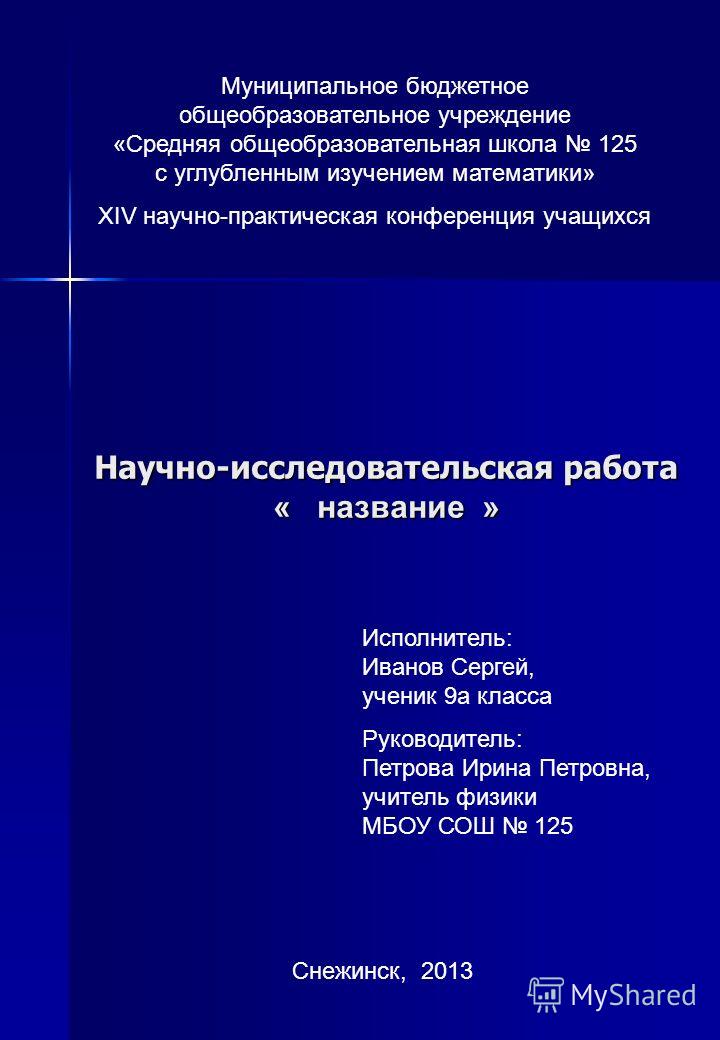
Contents Introduction 3 1. Chapter 1. (Title) (Subsection title) (Subsection title) 9 2. Chapter 2. (Title) (Subsection title) (Subsection title) 14 Conclusion 18 References 20 Appendices 21 2
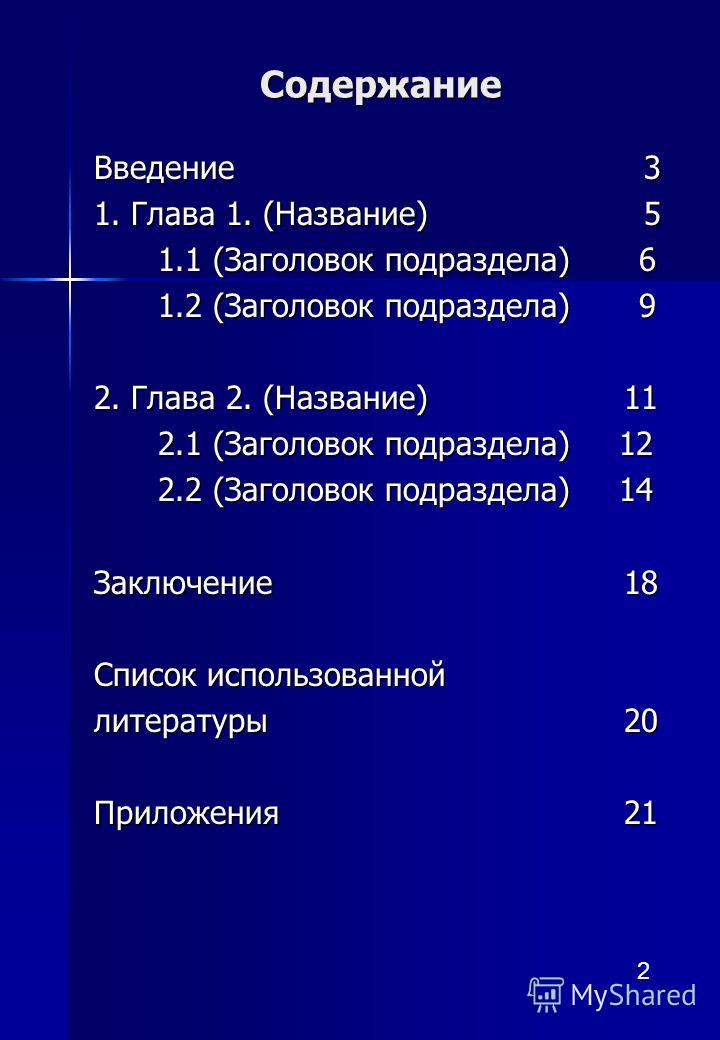
Introduction (dot at the end of the title of the section is not put) Introduction text: - Relevance; - Novelty of the topic; - Grade state of the art problem being solved; - Justification of the need for this work; - Objective; - Methods and techniques that were used in the work. Each section starts on a new page. The distance between the title and the text is 2 spacing. 3
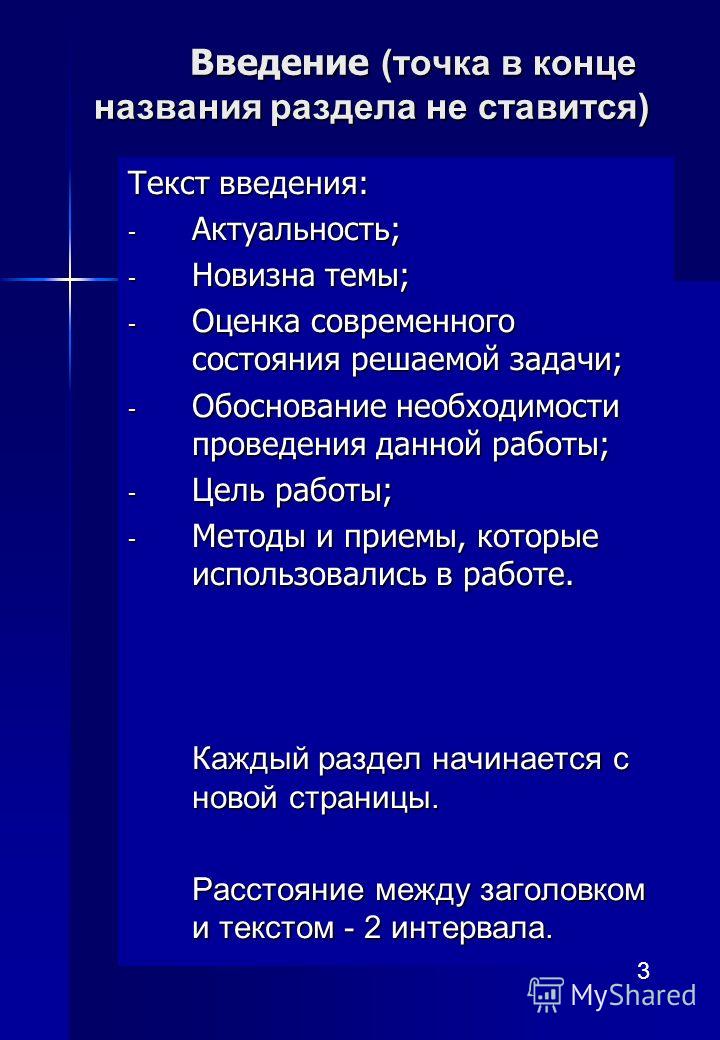
Chapter 1. (Chapter title) The text of the chapter. 1 chapter turn on lighting theoretical foundations the problem posed. This chapter can show the process historical development analyzed problem. Chapter 1 should demonstrate students' knowledge of literature and the ability to work creatively with it, highlight the main problems, compare different points of view on the issue under consideration. Chapter 1 should become the basis for the analysis of the entire work. 5

Chapter 2. (Chapter title) The text of the chapter. Chapter 2 analyzes the materials on which the work is performed. There should be identified shortcomings and the reasons that give rise to them. The materials of the analysis are summarized and ways of improving the existing mechanism are outlined. On the basis of the considered theoretical and practical material, an own approach is developed to eliminate the shortcomings. The author's approach is the subject of protection. eleven
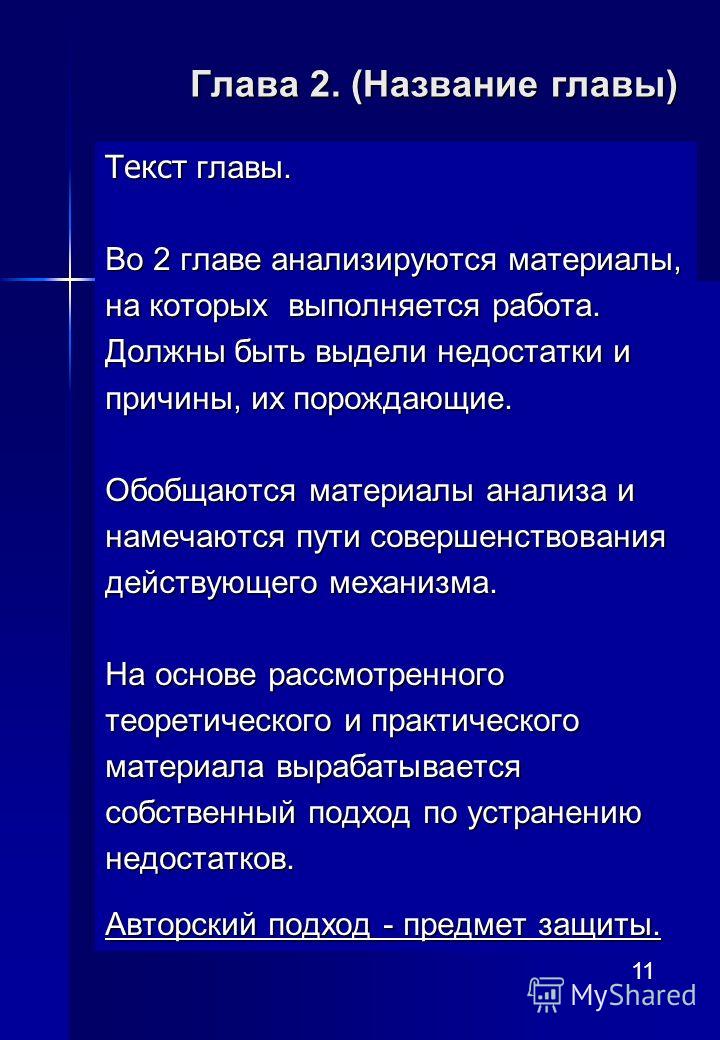
Conclusion The text of the conclusion The conclusion should contain brief conclusions on the results of the work performed, proposals for their use, including implementation, evaluation of the effectiveness of implementation. References to literature and applications are in brackets, in the same font. eighteen
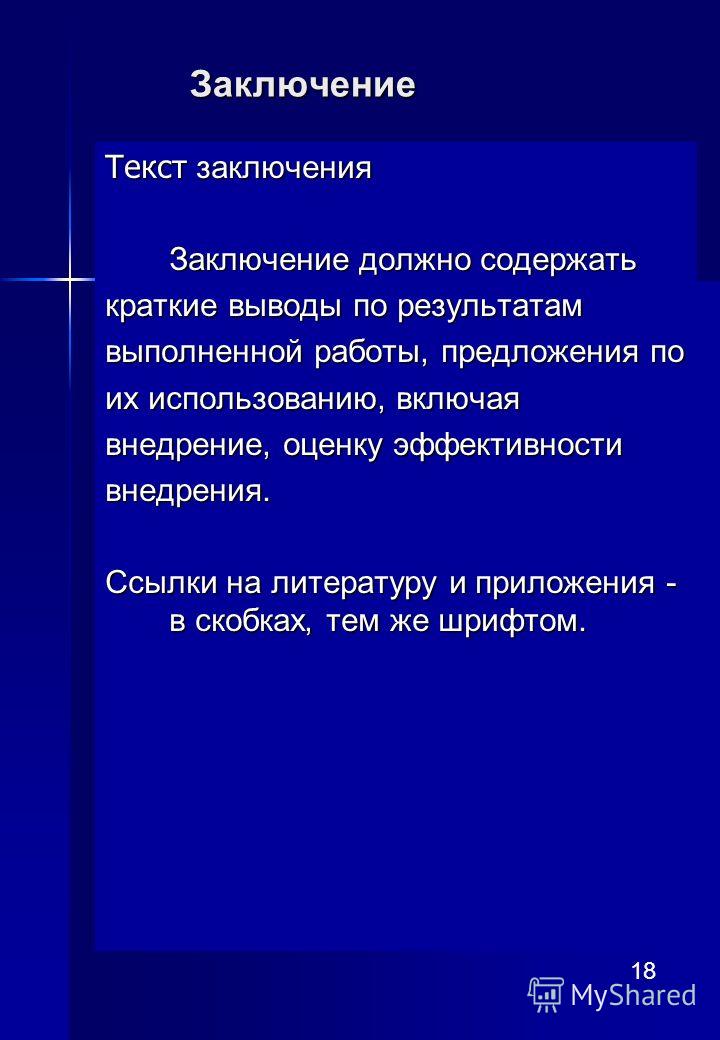
List of references Compiled in alphabetical order or as they are mentioned in the text of the work. Example: 1. Nikiforov A.D. Technical measurements.- M.: Enlightenment, p. 2. Yakovlev M.K. Electroexplosive drying // Food industry with Makarov V.L. History of our city // Window: City weekly newspaper. - April Snezhinsk. 4. Trukhina M.D. Nitrates and ways to reduce their content in vegetables.www.1september.ru 20
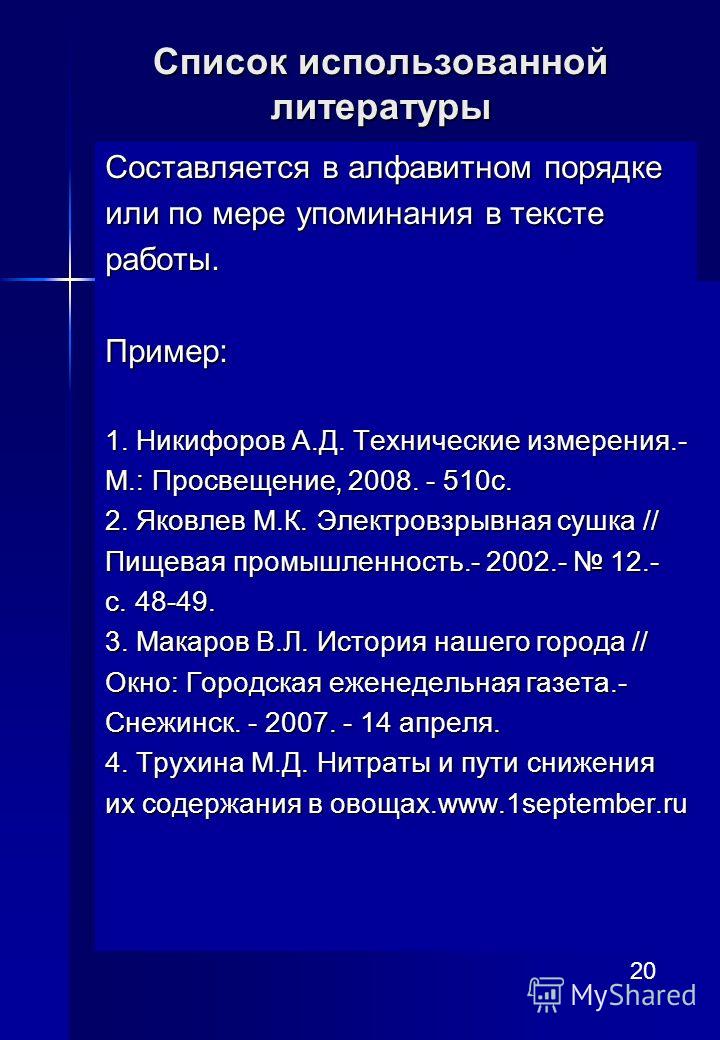
Organization of the conference of the year March 21 in the assembly hall Opening of the conference. 2. Work in sections according to classrooms. 3. Awarding of winners and participants. 4. Closing of the conference. Until March 15, submit an application for participation in the conference. Submit your work to the jury.
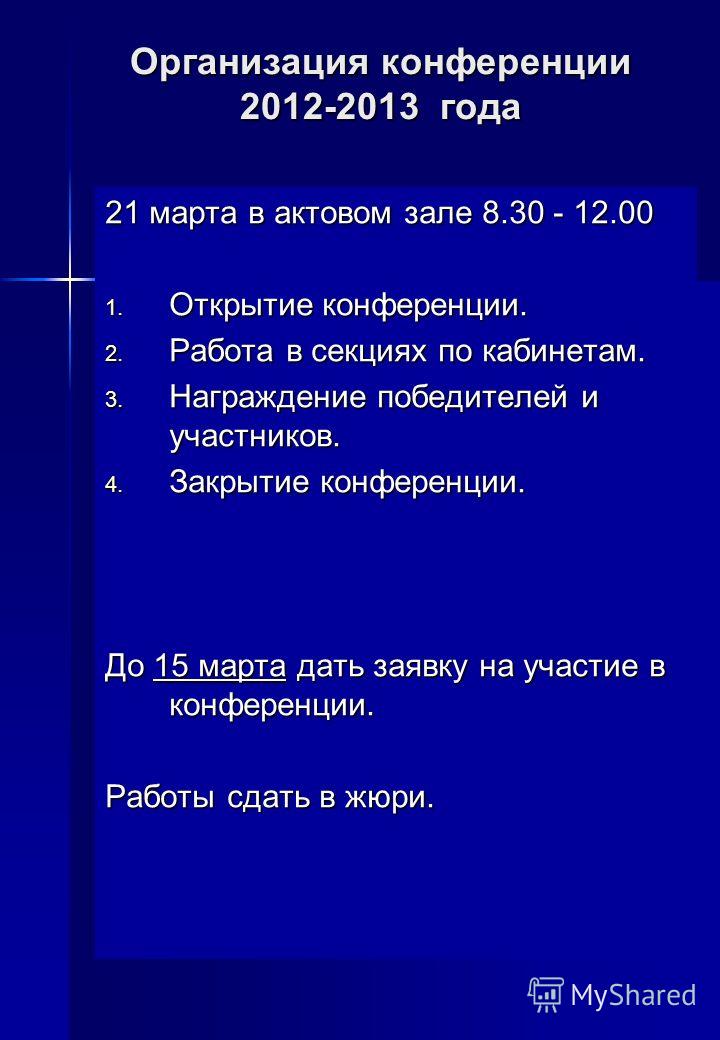

How to write a research paper
and prepare for the conference
Research completed. Now it is necessary to properly issue it, observing all the requirements and prepare for a presentation at a conference at which students will introduce their work to those present.
correct execution of completed work will provide the speaker with half the success at the conference. Therefore, we can recommend that students and their leaders adhere to the following rules:
1. Before you start writing and designing your work, carefully read the Terms and Conditions of the Contest or Conference in which you want to participate.
2. Please note that the research work must have a certain volume, be done in a certain font with respect to the intervals.
3. Check the text of the work in terms of lexical and stylistic literacy of the presentation, removing unnecessary repetitions, false solemnity, pathos, emotionality.
4. Check in reference books and encyclopedias the historical dates and facts mentioned in the text, last names, first names and patronymics, dates of life of individuals, etc.
5. Work applications must be annotated. Make the necessary captions for drawings, diagrams, photographs, etc.
6. When quoting individual statements, different points of view, memoirs, it is necessary to correctly format the references to the source: in parentheses indicate the author of the statement, year or in square brackets - the number of the source in the list of references. When using any other information carrier (video recording, audio cassette, letter, certificate, etc.), it is necessary to indicate where this primary source is stored (museum, state or personal archive indicating the fund and other output data).
7. Properly compose the work, highlighting the introduction, description of the study and conclusion.
Structure research work
· Title page
· Contents
· Introduction
· Heads of the main body
· Conclusion
· Applications
Title pageis the first page of the research work and is filled out according to strictly defined rules.
The top field contains the full name of the conference.
In the middle field, the title of the work is given, which is given without the word “subject” and is not enclosed in quotation marks. Do not put a dot after the title.
Please note that when formulating the topic of the work, it is necessary to reflect the problem raised in the study itself. You should not use quotes or epithets from fiction for this.
The bottom field indicates the place of work and the year of writing (without the word "year").
Table of contentsshould contain the titles of all chapters of the work, paragraphs and page numbers from which they begin. Headings in the table of contents should exactly repeat the headings in the text. You can not abbreviate or give them in a different wording, sequence compared to the headings of the text. All headings start with a capital letter, do not put a dot at the end of the heading. The last word each heading is connected by a dot to its corresponding page number in the right column of the table of contents.
Introductionis a crucial part of the work, since it contains in a concise form all the provisions substantiated by the study. The introduction should consistently consist of the following parts: substantiation of the topic, its relevance.
The relevance of the topic is an explanation of why it is advisable to address this topic right now, what is the scientific and practical need, what is the state of modern scientific ideas about the subject of research.
The substantiation of the relevance of the topic should be followed by consideration degree of scientific development of the problem. Here it is necessary to list past and modern researchers who have dealt with this problem from various angles, indicate insufficiently illuminated points. It is possible to substantiate the appeal to this particular topic, for example, by its insufficient research. Here you need to demonstrate that you are well accustomed to the topic and own the material.
After considering the degree of scientific development of the problem, a smooth logical transition to the goal of the study is carried out.
Purpose of the study – it is his final desired result, the solution of a scientific problem, to which in the end it should come. Do not confuse goals and objectives.
Research objectives are ways to achieve a goal. The formulation of research objectives is necessary to specify the objectives of the study. Tasks can be aimed at identifying, analyzing, generalizing, substantiating, developing, individual components common problem. At the same time, it must be remembered that the enumeration of tasks sets the plan and the internal logic of the text of the entire work.
For example, Subject: Partisan movement Ulyanovsk region (according to the memoirs of contemporaries). Purpose of work: Show history partisan detachments on Ulyanovsk land based on the memoirs of contemporaries. Objectives: 1) to identify and summarize the literature relating to partisan detachments in the Ulyanovsk region; 2) identify archival documents, letters, memoirs on the topic under consideration; 3) find participants, eyewitnesses of those events; 4) write down memories; 5) to analyze, on the basis of published and unpublished memoirs, the history of partisan detachments in the Ulyanovsk region.
Legislative (decisions, resolutions, orders, etc.)
Unpublished (archival documents (clerical documents) - indicating the full name of the archive, funds, types of documents; memoir sources - the memories you collected; epistolary - letters)
Main partwork in terms of volume should be approximately 70% of the entire text and be consistent in its structure with the plan. Here, the course of the study is described in detail, intermediate results are substantiated and analyzed. The fundamental requirements for the main part are evidence, consistency, the absence of superfluous, optional and text-cluttering material in it.
The text should be divided into large (chapters) and small (paragraphs) parts. The division into large parts of the work is dictated by the internal logic of the work. For example, if the chapter is divided into paragraphs, the latter should not duplicate each other in meaning, but in their sum should completely exhaust the content of the chapter as a whole. Chapters and paragraphs should be titled so that the title exactly matches the content of the text, but should not contain unnecessary words.
Chapters and paragraphs are numbered using Roman and Arabic numerals.
Formatting text is one of the most important steps in the work.
Cardinal numbers are written in numbers if they are ambiguous and in words if they are unambiguous
Ordinals are written in numbers if they are after a noun (for example, in chapter 1, captains of the 1st and 2nd ranks, 3rd round).
Abbreviations: city - city, year, years. – year(s), c. - century, c. - century.
Dates. They are written in numbers. For example, 1941; 1941–1945; 1940s, 1930s-1940s; 40s of XX century The centuries are written in Roman numerals: XVIII century; in late XIX- the beginning of the XX century.
In the text, the requirement is footnotes on the literature or source used. The given facts, dates, quotes must necessarily have a footnote. Footnotes are formatted as follows: on the panel, the following operations should be performed sequentially: "insert" - "link" - "footnote" - "footnotes at the bottom of the page or at the end of the document".
Footnotes to archival documents should be formatted as follows:
The full name of the archive (in the first case) and a short name, number of the fund, inventory, file, sheet. The type of document is not written in the footnote, but is written in the text of the work. For example. In the text you write: In the metric book of the Nikitskaya Church in Kaluga, there is a record of death on May 23, 1898 from pneumonia1.
The footnote reads: State Archive of the Kaluga Region (GAKO). F. 33. Op. 4. D. 56. L. 23v.–24.
If the footnote is at the end of the sentence, the number of the footnote is placed before the dot (for example, In 1795, the son Ivan1 was born.)
If in the notes to the text there are consecutive references to the same source or work, then from the second case it is written: "Ibid" (for example: 1GAKO. F. 33. Op. 4. D. 564. L. 23v.– 24.2 Ibid.)
If in the text you refer to the same work more than once, then the full bibliographic description is given only the first time. (For example, in the first case - Malinin of the historical guide to Kaluga and the main centers of the province. Kaluga, 1992. P. 23. in subsequent cases - Malinin op. P. 56).
In the work, it is necessary to avoid presentation in the first person (I, in my work), follows (in the present study, in this work, the author came to a conclusion, we draw a conclusion, in the conclusion it should / should be noted, etc.).
It is very important that each paragraph and chapter ends with a conclusion. The ability to draw conclusions based on the analysis of sources and literature is of great importance in evaluating work.
The text of the study should be justified. Headings - "in the center", they can be highlighted in "bold" font.
Conclusion -the smallest part, but of particular importance, since it is here that the final results of the study should be presented. Here it is necessary to bring together all the conclusions in the work, correlate the findings with the goals and objectives, show how the tasks and goals were achieved, note practical significance research, identify problems and challenges for the future. If necessary, thank those who assisted in the work.
List of sources and literature should be built like this:
I Sources
State Archive of the Kaluga Region (GAKO). F. 32. Op. 4. D. 68, 89, 789; F. 62. Op. 2. D. 15; Op. 5. D. 56, 78, 901.
State archive of the Kuibyshev region. F. 44. Op. 1. D. 18, 19, 22, 45; Op.2. D. 10, 19; F. 71. Op. 1. D. 56; Op. 4. D. 34, 35, 40.
School Museum of Military Glory. Main fund, inv. No. 125. Letters from the front.
Kaluga region: Documents and materials. Book Four / Comp. ; Foreword to ch. . Tula, 1987.
War through the eyes of children. Collection of documents / Comp. , etc. Kaluga, 1993.
II Literature
Literature should be placed in alphabetical order (by author's last name) in accordance with the rules of bibliographic description. The description may be in full or short form. For example, full form: Malinin historical guide to Kaluga and the main centers of the province. - Kaluga: Golden Alley, 1992.
short form: Malinin historical guide to Kaluga and the main centers of the province. Kaluga, 1992.
In work, you can use any method. The main thing is to maintain uniformity.
Examples of bibliographic description:
Please note that it is necessary to indicate the author and the title of the article.
Proshkin of the Old Russian settlements of the Upper Ochi // Questions of archeology, history, culture and nature of the Upper Ochi: Materials IX conference March 21–23, 2001, part 1. Kaluga, 2001, pp. 34–42.
Applications. Auxiliary or additional materials are placed here that clutter up the text of the work (schemes, drawings, developments, photographs).
Each application sheet must contain the word "Application I", "Appendix II"
If more than one material is used in an application, make a list of applications that are numbered in Roman numerals.
At finalization number all pages, including appendices. Pagination starts with title page, but pages are written starting with the introduction. This will be page 3.
Report requirements (research paper defense).
The report at the conference should not be exactly the repetition of the submitted written work. There are also certain requirements:
1. The duration of the report should not exceed 10 minutes (these are 2-3 pages of printed text).
2. Illustrative material should be spectacular, compact, easy to transport. If there are video materials, it should be taken into account that their demonstration is included in the same 10 minutes of the report.
3. Showing originals is not allowed! Replace them with well-executed photographs, photocopies.
4. In the oral defense of the work, the student must clearly identify the purpose and objectives of the study, give brief description sources, determine the methods and techniques of research. Present to the audience and the jury the most significant provisions of your research, focusing on your personal contribution to the problem under study, report final result and research perspectives.
5. Think in advance of possible questions that can be asked to the speaker and prepare answers to them.
6. When answering a question, concentrate all your knowledge and try to show it.
Take an active part in the work of the section: carefully listen to the reports and recommendations of the section leaders, ask questions to the participants. With properly organized work of the expert group, after the reported material, a discussion of schoolchildren is organized. The commission usually encourages children to be active.
Repeated participation in conferences, competitions activate the mechanisms of labor, knowledge, and communication. This not only increases the overall organization and effectiveness of education, but also accelerates the achievement of its goals related to multilateral development and the formation of attitudes towards the environment.
Involving students in the search for something new, contests and competitions increase cognitive interest and, on the basis of scientific and creative work, develop elements of patriotic education.
And whatever the results, in them, as in any other products of children's activity, the attitude to history, culture and nature, formed by upbringing and activity, finds a vivid expression. This relationship is relatively easy to trace by the external signs of behavior, which becomes especially striking in the conditions of competitive activity.






